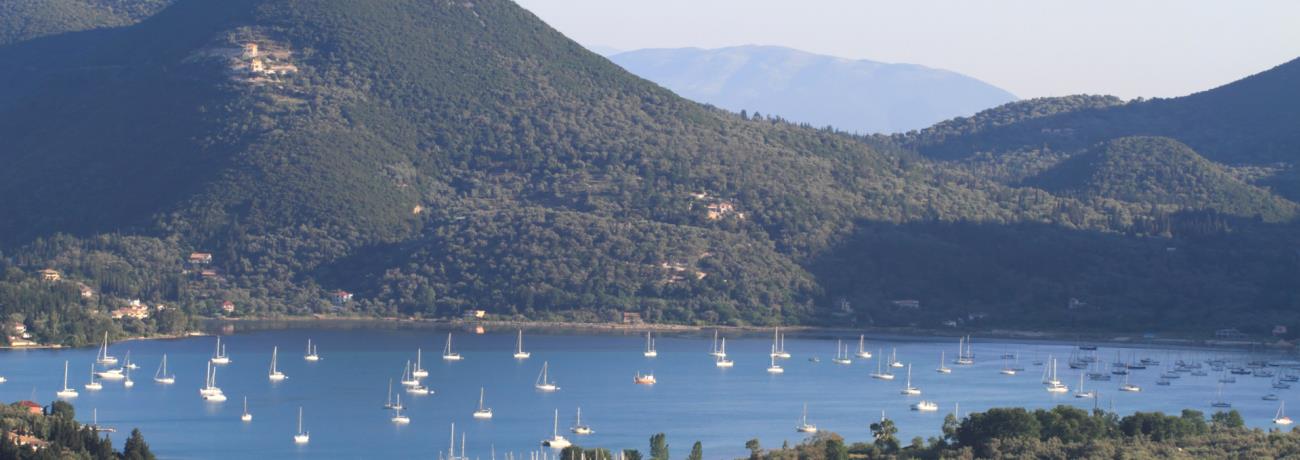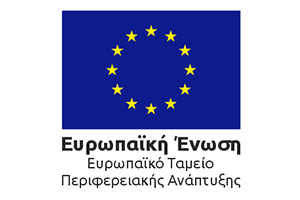Nydri and the surrounding area of the
Municipality
of Ellomenos are located on the south-east side of Lefkada. It has many outstanding
physical beauties, both on the coasts as well as the hinterland, which leave every
visitor in awe. In this region the morphology of the earth varies. It combines
the island's largest fertile plain, Englimenos, with the mountain ranges of
Platystoma,
Vakeris,
Neochori,
Alatros
and
Fternos, with the
beaches and tourist resorts that are visited by thousands of holiday-makers.
The large, leeward bay of
Vlychos,
which extends far into the dry land, constitutes an excellent natural harbour,
hospitable to all the boats which sail in the waters of the Ionian Sea. The whole
of the Vlychos peninsular is a luscious green which hugs the coast and reaches
round as far as the opposite side from Nydri. It is as though the islands of the
Prinkiponisa (Prince's Islands), which are small wooded islands,
Skorpios,
Skorpidi,
Madouri,
Sparti
and, further away, Meganisi float upon the calm sea. And opposite, on the edge
of the horizon, the coast of Akarnania on the Greek mainland, frames this unique
and exquisite picture, a picture which differs during every hour of the day. A
few years ago, Nydri and its surrounding area was nothing more than a small fishing
community. Most of the inhabitants lived in small, semi-mountain villages located
higher up, at
Rachi,
Vavkeri and Platystoma,
and were involved in agriculture, live-stock rearing and fishing, as were all
the villagers of the island. The rapid development of tourism gave the area a
great push and won over the majority of the locals. Today, the place is very different
from how it was in the past.
In addition, the development of tourism also changed the demographic
distribution. The residents moved from the interior mountain massifs to the coasts,
where they became involved in tourism, at the same time continuing their winter
agricultural occupations in the villages. The whole of the coastal zone from the
village of
Periyiali
as far as Vlychos has merged into one compact area. There are dozens of luxury
hotels and rented rooms, restaurants, shops and tourist offices which offer up-to-date
tourism facilities, serving the most demanding visitor.
The beautiful and immaculately clean sandy beach, which stretches
out for kilometres ahead, provides bathers with the opportunity to try out all
kinds of water sports.
Even though the area is quite developed touristically, it has not
lost its natural beauty. Thick vegetation with olive trees, pines and cypresses
provide a framework for the carefully constructed tourist infrastructure. The
orderliness and cleanliness help to maintain exceptionally civilised surroundings.
The region's beauties are not just limited to its sandy beaches and to its cosmopolitan
character, though it has many important historical, natural as well as cultural
monuments to show, both along the coast and inland.
With Nydri, Lefkada's most visited tourist resort, as a starting point,
we commence on our first route a little outside the centre of the village. The
visitor will be able to enjoy the region's beautiful landscape, with the rich
olive trees, fertile orchards and vegetable gardens to the west. This route can
be made in combination with a delightful walk which passes through the area of
the excavations, wedged in between the sea and the mountain, in the area of the
Steno Haradiatikon and which leads on to Vlychos. This is where the German archaeologist
Wilhelm Dorpfeld discovered some tombs and circular buildings, showing that the
region was inhabited from at least the Early Bronze Age (2000 BC).
Dorpfeld was he inspiration behind the theory, based on one interpretation
of the Odyssey, that Lefkada was indeed Homer's
Ithaki,
and placed Odysseus' palace at Nydri. Many of Dorpfeld's finds - votive offerings,
vases and Mycenean remains - are on display in the
Archaeological
Museum of Lefkada. Dorpfeld himself loved the island so much that he wanted
to be buried here. His grave is located on the peak of the hill at the edge of
the Vlychos peninsula, above the charming little church of Ayia Kyriaki. There
is a theory that this little church is built on top of an ancient temple of the
Nymphs.
Continuing from Vlychos turning to the left, the route continues between
two ancient olive trees in the verdant region of Yeni, in front of the beach of
Desimi. A small footpath at the end of the road leads to the little church of
Ayia Kyriaki, offering another view of Nydri which is as equally amazing. The
journey to Ayia Kyriaki can also be made in a small, rented caique. A small, uphill
road above the bay of Vlychos leads to the village of
Haradiatika
and continues from there to the hamlet of Alatros. Just like all the other tiny,
mountain villages of the region, Alatros is today abandoned...
There are many water-mills preserved in the ravine, remnants of the
agricultural life of the place and testimony to the existence of strong-flowing
waters which the locals used in order to grind their crops. Ascending southwards,
after Vlychos we reach
Katochori.
This is a small, picturesque hamlet with stone-built houses. It was once the seat
of the Municipality and the buildings which housed the public services, such as
the courts, still stand. In this village is the church of Ayios Haralambos, with
icons dating to the 16th century.Further south on this route, on the left of the
central road, is
Poros,
an old village which clambers up a steep slope in a westerly direction, as though
it has turned its back to the sea. This village is surrounded by green vegetation
and looks as though it lives according to its own peaceful rhythms. Above the
village, at a distance of less than 800 metres, are the remains of a tower, from
which a lookout was obviously kept over the whole of the surrounding region.
According to Dorpfeld, this tower, as well as the remains of an ancient
olive-press which was found here, date to approximately the 4th century BC. After
Poros, the road descends through the village and leads down to two delightful
sandy beaches, Rouda and Mikro Yialo, which lie next to each other, impressing
the visitor so much that he will not know which one to choose first. And here
the water is brilliantly clean and crystal-clear, a deep blue, whilst the green
of the vegetation is reflected on its surface.
Continuing in a southerly direction, the small village of
Fterno
is to the right of the central road. From here the view over Rouda is magical.
This is where the road which leads through the ravine of Haradiatika ends, offering
the visitor the especial pleasure of being able to go on yet another exceptional
ramble and to discover the region's natural beauties. A second route starts from
Nydri and follows a slightly upward road which leads, through a verdant landscape,
to the farming hamlet of
Rachi.
From here, ascending towards the west, we encounter a shadowy footpath which clambers
up the slope of the Dimosari ravine.
This footpath has been hewn through the rock and is secure; it is
quite perfect for the summer months. At the end of the footpath there is a series
of rocks over which water rushes quite forcefully, creating a waterfall. The water
collects in a natural basin. In the summer there is less water, but the ramble
through the verdant and refreshing landscape is still exceptionally pleasurable.
The Dimosari ravine is considered to be an important wetland. In his poems, the
poet Aristotelis Valaoritis has sung the praises of the flowing water, gazing
over at the landscape of Madouri.
A few kilometres above the village of Rachi is Vavkeri, another of
the region's picturesque mountain villages, full of greenery and with plenty of
water. The history of the village begins in the 16th or the 17th centuries. Today
there are only a very few residents left. The view over Nydri from here is truly
magical.




